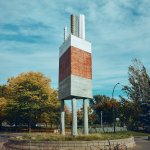

Gilles Mihalcean has been a self-taught sculptor since 1969. Though he spent a bit of time teaching at the Université Laval, he has devoted himself to his art since 1972.
As well as working on monumental pieces for public art projects and to integrate art to architecture, he also regularly presents his work in collective and special exhibitions. Since 1980, he has been one of the major names in the resurgence of sculpture. His work was showcased at the Musée d’art contemporain de Montréal (1988) for contemporary sculpture exhibits and at The Power Plant in Toronto (1988). As a solo artist, his art was showcased in Montreal galleries and art centers (René Blouin, Chantal Boulanger, Roger Bellemare and Circa) as well as Canadian ones (Southern Alberta Art Gallery) and in New York (49th Parallel, Centre for Contemporary Canadian Art). In 1995, the Musée d’art contemporain de Montréal dedicated a retrospective exhibit to him, and was recently on display at the Musée d’art de Joliette (2007).
Mihalcean’s sculptural work is deeply lucid and leads us to more lurid and critical pieces. Time is a fundamental aspect of his art; may it be the time needed by the creator, the time token by the spectator when observing the piece and the time absorbed by history – visible in nearly all his art.
Mihalcean is known for his pieces filled with conceptual dichotomies which lead the observer to reflect. His pieces are often tripartite and the meaning that somebody could find in the close proximity between two elements is often shattered by the third. This principle is supported by the use of contrasting materials and many interrelationships. It also isn’t rare that the artist invite spectators to touch his sculptures and feel them in order to better understand them.
Artwork description
This geometric composition is a tribute to the history of Pointe-Saint-Charles. Sensitive to an aesthetic of juxtaposition, Mihalcean offers a metaphor for the neighbourhood. The lowest part of the triangular prism, made of green-coloured concrete, refers to the historical importance of Irish immigrants to this area. The central section, made of red brick, reflects the working-class housing in the neighbourhood. The third part, topped with three chimneys, underlines the industrial past of the sector. The pillars that support the structure are reminiscent of the past presence of marshes on its banks and provide the artwork with a sense of fragility.
In this 14-metre-high commemorative artwork, the evolution of Pointe-Saint-Charles takes the form of a sedimentation of bygone times. Installed in a traffic circle, Monument à la Pointe is seen from a distance and marks the border between the space devoted to road transport and the residential space.


